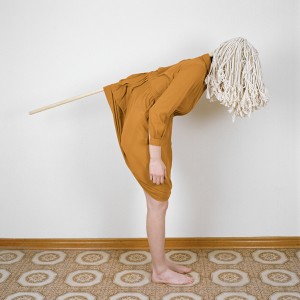Alex Kisilevich: The Camouflaged Man
Sometimes teaching classes, he learns more to help his students as well. If he does not rely heavily on those heavy-weight creators who preceded him, he has his contemporary favorites. One of them is Swedish filmmaker Roy Andersson.
“He played a big role in how I started looking at images. His films are all basically stills. The camera remains stationary. Scenes unfold slowly over time even though the camera stays the same,” Kisilevich explains.
Another influence for him is the New York-based artist, Olaf Breuning. One highly original, staged work of Breuning’s was photographing the Moai sculpture heads on Easter Island by setting up a series of rabbit ears in the foreground of his image. Such improvised sense of play is also present for Kisilevich; Thunder as Wolf as Sheep pictures a dog in a synthetic sheep’s snowsuit, posing contentedly in the snow drifts.
Some of Kisilevich’s images distort our perceptions of reality to such a degree that we can only wonder how they were created. He sees his process as much simpler than what might be imagined. Working with digital chromogenic prints is analogous to working in a standard darkroom, but the printing is done with lasers rather than enlargers. He shoots with a film camera and then scans the image. One of these images was done when Kisilevich was in the middle of preparing for his Bachelor’s degree. It involves a mundane scene in a parking lot, the subject standing alongside his car, but encased in a gigantic bubble — darkroom mumbo-jumbo, maybe?
Hardly the case, as he explained, “I was in my final year at OCAD and I thought it was going to be my final year’s work. I had invested a lot of time and finances which included purchasing a plastic inflatable bubble from China and I placed the subjects inside. I used a leaf blower to inflate it, and there was a zipper attached to the bubble for the subject to enter that was later edited out.” The result is a finely tuned bubble that mystifies the viewer.
Purchasing props from China wasn’t his only contact with the country. His work was recently featured in a group show in the remote province of Lianzhou, China. A curator at the International Center of Photography invited him to participate but, unfortunately, a personal accident prevented him from attending. He was both shocked and happy at the invitation and joked about the possibility that the whole thing might have been staged. After all, a small coterie of people ventured the same idea that Neil Armstrong’s moonwalk in 1969 could have been a hoax. (We shared a good laugh over that premise, but I reassured him that the exhibit was very real indeed.)
One of Kisilevich’s staged photographs, Spilt Drink, presents a young man and woman, holding hands over a tabletop, with two wine glasses between them. The young man’s shirt and face is dripping and the girl’s glass is empty. The viewer might draw the conclusion that she has just spilled the wine over her companion. Conversely, the man’s countenance is so Christ-like, and the figures so frozen in their pose, that it’s hard not to give the whole scene a more religious interpretation. Was this meant as a piece of performance art as well?
Not necessarily. There are two early images — Salesman, which portrays a man standing behind a taxidermy deer, the deer eerily obstructing the man’s head from view, and in another piece, a pair of prosthetic legs protruding from a flesh colored wall — that became very personal for him. A little while back, before getting started on their creation, Kisilevich had lost a family member.
“They were part of a body of work called And Then You Die. Immediately after I finished my Bachelors, these two images stuck with me. I went immediately for my Masters at York, trying to think [of] what to do, and that’s when I realized that camouflage was so present. I noticed something being disguised or masked in the work and I used these images as stepping stones to make Kallima my thesis,” he says.
“But then I decided to go with the flow and let a bit of improvisation into my work to keep me on my toes,” he adds as he explains how when he first began photographing, he would make a drawing and meticulously recreate the scene later.
His willingness to experiment seems to be paying off. He has just been awarded a Visual Artists Grant for Emerging Artists from the Ontario Arts Council to “do everything but photography.”
Immersed in the current arts scene in Toronto, he is surrounded by “a lot of wonderful artists, critical of their own work.” But he admits to the insularity. “Everyone knows everyone, for better or for worse, I’m not sure,” he says.
XPACE, TIW, and the Angell Gallery are just some of the galleries that have been eager to exhibit his works. Does he see himself moving beyond?
He emphasized that it’s possible for local artists to stay in Toronto and make a career, but admitted that some have dreams of showing all over the world.
“I would love to take a temporary break. I wouldn’t mind spending some time in Berlin. Being out of your comfort zone is a good way to initiate a different type of work,” Kisilevich says.
For now, his recent grant will no doubt require his staying put in the Toronto he knows so well. But rest assured, even if Kisilevich’s creations are often under wraps, this is one artist who won’t stay camouflaged for long.

